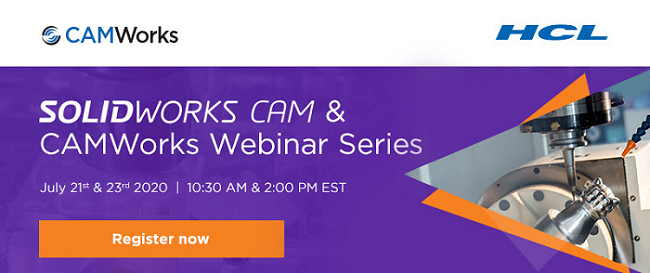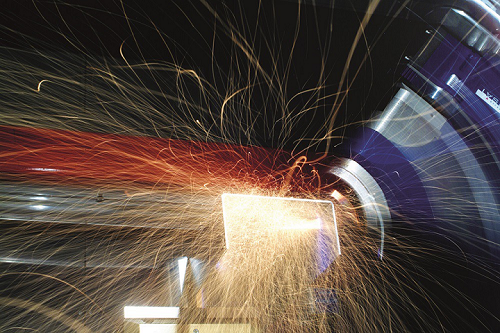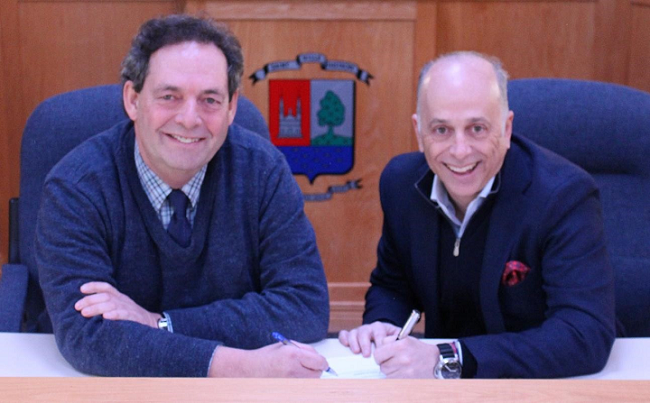Russian state successfully flight tests 3D printed gas turbine engine
3D Printing Webinar and Virtual Event Roundup, July 19, 2020
A variety of topics will be covered in this week’s webinar and virtual event roundup, including additive manufacturing in aerospace, CAMWorks, product management, post-processing, and more. Read on to learn more about, and register for, these online opportunities.
AM in Aerospace Virtual Panel
On Tuesday, July 21st, Women in 3D Printing (Wi3DP) will host the third event, “Additive Manufacturing for Aerospace”, in its virtual panel series. Sponsored by AlphaSTAR and Link3D, the panel will focus on how AM is used in the aerospace industry. Moderated by AM-Cubed founder Kristin Mulherin, the speakers are Anna Tomzynska, Director and Additive Manufacturing Chief Engineer for Boeing; Deb Whitis, GE Aviation Chief Engineer; and Eliana Fu, Senior Engineer, Additive Technologies, at Relativity Space.
Pre-registration will begin at 11 am EST, with a welcome speech at 11:25. The hour-long panel will begin at 11:30, with plenty of time for live Q&A, and there will be a virtual networking reception at 12:30. Register for the virtual panel here.
3DEO Webinar – Why I Switched From CNC Machining
Also on July 21st, metal 3D printing company 3DEO is hosting a live webinar, entitled “Why I Switched From CNC Machining: An Engineer’s Perspective on Transitioning to Metal 3D Printing.” The webinar, which starts at 1 pm EST, will feature 3DEO Applications Engineer Julien Cohen, who will explain the major differences between metal 3D printing and CNC machining. The following topics will be covered:
-
Compare CNC machining and 3DEO’s proprietary metal 3D printing process
-
Understand the value metal 3D printing offers engineers in design and flexibility
-
Learn about the pros and cons of each process and when metal 3D printing makes sense
-
Discover three real-world case studies of 3DEO winning versus CNC machining
-
See 3DEO’s process for going from first articles to production
You can register for the webinar on 3DEO’s website.
Free CAMWorks Webinar Series
To make sure professionals in the CAM industry have easy access to educational and training materials during the COVID-19 crisis, a free CAMWorks webinar series has been launched. Each session will give attendees the opportunity to increase their CAM skills, learning about more advanced features that can help maintain business operations. “SOLIDWORKS CAM and CAMWorks: Getting Started” is on Tuesday, July 21st, at 10:30 am EST, and will be a training session on using the integrated CNC programming system SOLIDWORKS CAM Standard. It will also provide an introduction to the Technology Database (TechDB), which can automate the CNC programming process. “SOLIDWORKS CAM for Designers: A Path to Better Designs” will also take place on July 21st, at 2 pm EST, and will focus on how to use SOLIDWORKS CAM to reduce cost, improve design, and make it easier to manufacture parts.
You’ll need to attend the “Getting Started” webinar before attending “SOLIDWORKS CAM and CAMWorks: Getting Started with the TechDB” on Thursday, July 23rd at 10:30 am EST. This is a more in-depth training session for using the TechDB included in SOLIDWORKS CAM and CAMWorks. The final webinar in the series is “The Future of Manufacturing in the COVID Era,” also held on July 23rd, at 2 pm EST. This session will help attendees learn how to automate part programming to stay productive and competitive during and after the pandemic.
Protolabs Webinar: HP’s Multi Jet Fusion
On Wednesday, July 22nd, at 2 pm EST, Protolabs will be hosting a webinar with HP, called “Tips and Tricks to Leverage Multi Jet Fusion in your Product Development Cycle.” One of the company’s Applications Engineers, Joe Cretella, and Brent Ewald, HP’s Solution Architect, will discuss design tips that result in good MJF parts, how to implement the technology, and where MJF fits within additive and subtractive manufacturing.
“This webinar will help attendees understand how the HP Multi Jet Fusion technology 3D printing process can be leveraged in various stages of the product development lifecycle. The experts at HP and Protolabs have teamed up to give you key insights into Multi Jet Fusion materials, processing capabilities, and part quality. Whether the attendee is new to additive manufacturing or evaluating Multi Jet Fusion for their production project, this presentation will help identify when the technology provides the most value and what to consider when manufacturing Multi Jet Fusion parts.”
Register for the webinar here.
Dassault Systèmes on Project Management Solutions
At 10 am EST on Thursday, July 23rd, Dassault Systèmes will hold a live webinar,”Discover How to Deliver Projects on Time and Under Budget, a Real-time Online Experience,” all about collaborating with integrated project management solutions connected to 3D engineering data in order to drive project success. Dassault speakers Maximilian Behre, the Online Industry Business Consultant Director, and 3DS Industry Process Consultants Siddharth Sharma and Alessandro Tolio, will discuss project management challenges, shortening the design cycle through the 3DEXPERIENCE platform, provide a demonstration of Project Management on the cloud, and answer questions.
“Whether you are managing big programs that involve hundreds of people or are leading a smaller project, an easy to use integrated project management solution will help you to seamlessly collaborate across all disciplines with any stakeholder. Connect the dots between Marketing, Engineering to Manufacturing and customer services.”
Register here.
KEX Knowledge Exchange on Post-Processing
Finally, former Fraunhofer IPT spinoff KEX Knowledge Exchange AG is holding its second webinar on its KEX.net web platform, “Online Seminar Post-Processing for Additive Manufacturing,” on Thursday, July 23rd. Lea Eilert, the project and technology manager for the ACAM Aachen Center for Additive Manufacturing, will teach attendees about typical heat treatment for AM materials, the necessity of post-processing for 3D printed components, and various post-machining and surface finishing methods.
Register for the webinar here. In addition, Eilert will also present the third KEX webinar on August 6th, entitled “Market, Costs & Innovation.”
Will you attend any of these events and webinars, or have news to share about future ones? Let us know!
The post 3D Printing Webinar and Virtual Event Roundup, July 19, 2020 appeared first on 3DPrint.com | The Voice of 3D Printing / Additive Manufacturing.
U.S. Air Force & GE Collaborate in Parts Certification, 3D Print F110 Sump Cover
A collaboration that began last year between GE Additive and GE Aviation and the U.S. Air Force is now coming to fruition. As the U.S. Air Force sought help with creating a metal additive airworthiness and certification path, beginning mid-2019, they received a proposal from GE offering a streamlined plan for readiness, affordability, and sustainment in an AM program.
With some aircraft reaching 60 years of service for the military, the U.S. Air Force’s Rapid Sustainment Office (RSO) began considering better ways to perform maintenance and manufacture spare parts. As the GE team reached out to the ROS, they realized that GE had the experience in qualifying and certifying AM parts that they required.
“The RSO is excited to partner with GE Additive and its efforts to deliver additively manufactured parts for the Air Force,” said Nathan Parker, deputy program executive officer for the RSO who oversees and provides funding for the project with GE. “Their successes will help ensure our systems rapidly obtain the high-quality parts they need to stay flying and at the ready.”
As continued proponents of 3D printing and additive manufacturing processes—for years, before most people were even aware of such technology—both GE Additive and a variety of different military divisions have continued to innovate, expanding AM facilities around the world, developing new materials, and creating new parts for U.S. Air Force planes and even runways. In this partnership, the two organizations have developed a multi-phased program that ascends in both complexity and scale as each phase is completed.
“The Air Force wanted to go fast from day one and gain the capability and capacity for metal additive manufacturing, as rapidly as possible, to improve readiness and sustainability,” explains Lisa Coroa-Bockley, general manager for advanced materials solutions at GE Aviation.
“Speed is additive’s currency, and by applying our additive experiences with the LEAP fuel nozzle and other parts additively printed for the GE9X, being able to offer an end-to-end solution and also applying lessons learned of a robust certification processes, we’ve been able to accelerate the pace for the USAF,” added Coroa-Bockley.
The program, based on a spiral development model, begins with basic part identification and then moves forward to part consolidation and certifying more complicated systems like common core heat exchangers.
“The collaborative effort between the US Air Force and GE shows great promise toward the adoption of metal 3D printed parts as an option to solve the US Air Force’s current and future sustainment challenges. This capability provides an alternate method to source parts for legacy propulsion systems throughout their life cycle, especially when faced with a diminishing supplier base or when infrequent demands or low volume orders are not attractive to traditional manufacturers,” said Colonel Benjamin Boehm, director, AFLCMC/LP Propulsion Directorate.
So far, the collaborative team has completed Phase 1, identifying GE Aviation spare parts for the F110 and TF34 engines, and then evaluating and proving their readiness for flight. Work had already been started on a sump cover (in use already for F-15 and F-16 aircraft) for the General Electric F110 engine, and it became the focal point of the first phase in the program.
Phase 1b, in the planning stages, will reflect continued complexity in the stages, as the team works on a sump cover housing. This is a ‘family of parts’ currently found on the TF34 engine—part of an aircraft that has been in use for over four decades.
“Re-engineering legacy parts and additively manufacturing low quantities of traditionally cast parts has incredible potential to improve USAF supportability. It’s worth our focus to develop a fast, highly repeatable process,” said Melanie Jonason, chief engineer for the propulsion sustainment division at Tinker Air Force Base (AFB).
Excited about the project from the beginning, Jonason is working with the GE Aviation military team, the chief engineer, Dr. Matt Szolwinski, James Bonar, and a team of GE Additive engineers.
“Compared to other parts on the F110 engine, the sump cover might have lower functionality, but is incredibly important. It needs to be durable, form a seal and it needs to work for the entire engine to function – which is of course critical on a single engine aircraft like the F-16,” said James Bonar, engineering manager at GE Additive.
GE Additive and GE Aviation have worked together closely in designing the aluminum sump cover—with the first builds produced on GE Additive Concept Laser M2 machines running cobalt-chrome at their Additive Technology Center (ATC) in Cincinnati.
“The program with GE is ahead of schedule and the preliminary work already done on the sump cover has allowed us to move forward quickly. As we build our metal additive airworthiness plan for the Air Force, the completion of each phase represents a significant milestone as we take a step closer to getting an additive part qualified to fly in one of our aircraft,” said Beth Dittmer, division chief, propulsion integration at Tinker AFB.
What do you think of this news? Let us know your thoughts! Join the discussion of this and other 3D printing topics at 3DPrintBoard.com.
[Source / Images: Source / Images: GE Additive]
The post U.S. Air Force & GE Collaborate in Parts Certification, 3D Print F110 Sump Cover appeared first on 3DPrint.com | The Voice of 3D Printing / Additive Manufacturing.
Boeing 77X: GE9X engines with 300 3D printed parts powers largest twin-engine jetliner in first flight
€9.4M 4DHybrid project to bring hybrid additive manufacturing to MRO
GE Aviation buys 27 Arcam EBM 3D printers to work on GE9X engine
CFM International closes largest ever order for 3D printing enabled LEAP engine
3D Printing Industry News Sliced: AMUG, Protolabs, Essentium, Renishaw and more
GE News: Subsidiary AP&C Purchased New Land, GE Aviation Helping Airbus 3D Print Parts for RACER Aircraft
GE Additive‘s Canadian subsidiary, Advanced Powders & Coatings (AP&C), which produces and distributes metal powders for 3D printing, has been operating out of the Innopark Albatros in Saint-Eustache, Quebec since 2016. But last week, AP&C announced that it had purchased an additional piece of land at the location. This new location, just outside Montreal, is where the company will be concentrating its expansion activities in an effort to support its growth plans.
“We are thrilled to work with the dynamic Ville de Saint-Eustache team! Our firm is currently enjoying rapid growth and we need more space for our projects, along with a good location for drawing fresh talent. Innoparc Albatros meets both of these urgent needs,” said AP&C CEO Alain Dupont. “It is clear that AP&C’s future is right here in Québec and, in particular, Saint-Eustache!”
 This past Friday at the Saint-Eustache Town Hall, Dupont and Saint-Eustache Mayor Pierre Charron concluded the sale of the new, almost 40,000 square meter plot in the presence of Town Clerk Mark Tourangeau and notary Jean-Luc Pagé. AP&C already employs roughly 100 people at its Allée du golf facility in the Innoparc Albatros business district, but with this new addition, the company will be able to increase the amount of high added-value jobs in the area.
This past Friday at the Saint-Eustache Town Hall, Dupont and Saint-Eustache Mayor Pierre Charron concluded the sale of the new, almost 40,000 square meter plot in the presence of Town Clerk Mark Tourangeau and notary Jean-Luc Pagé. AP&C already employs roughly 100 people at its Allée du golf facility in the Innoparc Albatros business district, but with this new addition, the company will be able to increase the amount of high added-value jobs in the area.
“We are extremely proud that AP&C, the flagship of its industry, has decided to multiply its activities in Innoparc Albatros, thereby making big contributions to Saint-Eustache’s economy,” said Mayor Charron. “Innovation breeds more innovation and we are confident that AP&C’s increased presence will bring new businesses to our techno-park and encourage other hitech firms to come here.”
This new space will be a big help, as the company, which mainly serves the biomedical and aerospace sectors, distributes its powder products in over 40 nations.
But this expansion isn’t the only news GE is sharing. Speaking of aerospace, a new GE Reports has come out regarding the next-generation RACER helicopter hybrid by Airbus, which is the concept aircraft for the European Union’s Clean Sky 2 project.
“The future of flight is an ever-evolving topic ranging from new supersonic passenger jets to hybrid helicopter-like aircraft that fly more like a plane,” Yari M. Bovalino wrote in GE Reports.
“One recent example of such a flying machine is Airbus’ RACER.”
According to Airbus, the RACER, or “rapid and cost-effective rotorcraft,” can hit a cruising speed of over 400 km an hour, making it one of the fastest helicopters in the world. The RACER combines an airplane’s speed and distance capabilities with the helicopter’s versatility; i.e., it can take off and land vertically and also hover. This aircraft could bring about greener, faster, and less expensive air travel, which fits right in with the EU’s project goal of lowering the impact of aviation on the environment.
Over 600 entities in 27 countries are working together to develop more “environmentally benign” aircraft technology as part of the Clean Sky aviation banner. The goal is to lower nitrous oxide emissions by 80%, fuel consumption and carbon dioxide emissions by 50%, and external noise by 50%, when compared to their levels in the year 2000. Clean Sky is looking at the big picture to make a real difference, and working on things like improving wing aerodynamics.
 The RACER has a body like a helicopter, with a large rotor on top, but rather than a tail rotor, it has two skeletal wings, each with a backwards-facing propeller. One wing moves clockwise while the other moves counterclockwise, and the propellors work with the RACER’s low-drag wings to help it pick up speed while also maintaining lift.
The RACER has a body like a helicopter, with a large rotor on top, but rather than a tail rotor, it has two skeletal wings, each with a backwards-facing propeller. One wing moves clockwise while the other moves counterclockwise, and the propellors work with the RACER’s low-drag wings to help it pick up speed while also maintaining lift.
For a long time, aviation engineers have been looking for that special flight vehicle that’s fast, cost-effective, and agile at the same time…and it looks like the RACER is checking all of those boxes.
Tomasz Krysinski, head of research and innovation at Airbus Helicopters, said, “The RACER is 50 percent faster than a traditional helicopter, but has lower costs, and brings together several new technologies.”
In order to obtain the necessary technology to get the RACER flying, Airbus turned to England-based GE Aviation Integrated Systems and Avio Aero, an Italian GE Aviation company. The two are working on building the components and subsystems for the hybrid aircraft, such as the transmission system for the wing and rotor propellers and the RACER’s cradles, which connect the wings to the gearboxes.
 While traditional helicopter cradles were made with heavy parts that had been pre-made and were not cost-effective, the RACER’s cradles will be made with 3D printed casting molds, which helped lower cost, part count, and weight.
While traditional helicopter cradles were made with heavy parts that had been pre-made and were not cost-effective, the RACER’s cradles will be made with 3D printed casting molds, which helped lower cost, part count, and weight.
Paul Mandry, the engineering program leader for GE Aviation, said, “This is the first time we’ve ever designed such a complex cast component.”
The RACER also has some other new components that Airbus Helicopters and Avio Aero designed together, such as 3D printed heat exchangers for the transmission based on the experience that engineers gained while developing GE’s Catalyst engine. Because the craft is more lightweight, it will also save Airbus money on fuel costs over its lifetime, and will be much more environmentally friendly.
In order to take the RACER on its maiden flight in 2020, Airbus is planning to start assembling the first prototype later this year.
Discuss this news and other 3D printing topics at 3DPrintBoard.com or share your thoughts in the Facebook comments below.











